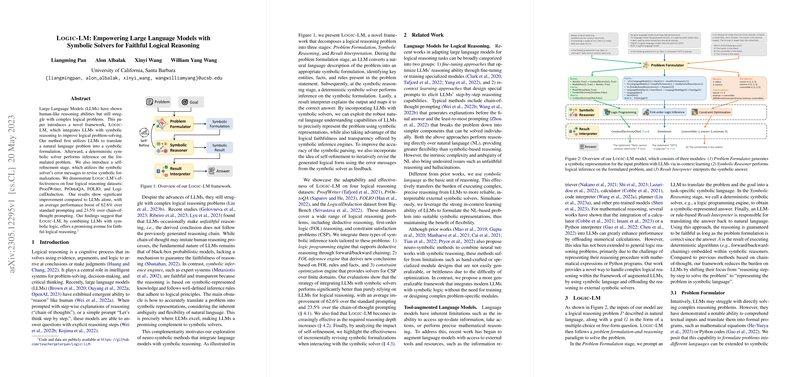Overview of Logic-LM: Enhancing Logical Reasoning in LLMs
The paper "Logic-LM: Empowering LLMs with Symbolic Solvers for Faithful Logical Reasoning" presents an innovative approach to improving the logical reasoning capabilities of LLMs by integrating them with deterministic symbolic solvers. Despite their demonstrated human-like reasoning performance, LLMs have shown limitations in handling complex logical problems, often resulting in unfaithful reasoning where conclusions do not logically follow the generated reasoning chain. This research introduces the Logic-LM framework, designed to enhance the faithfulness and accuracy of logical reasoning tasks.
Methodology
Logic-LM bridges LLMs and symbolic solvers through a three-stage process involving: Problem Formulation, Symbolic Reasoning, and Result Interpretation. Initially, LLMs are utilized to convert natural language logical problems into symbolic formulations, exploiting their linguistic understanding. This symbolic representation is processed by deterministic solvers to perform inferences, ensuring logical consistency. To address potential errors in symbolic formalization, a self-refinement module iteratively refines the logical representation based on error messages from symbolic solvers.
The framework is evaluated on a diverse set of logical reasoning tasks, including those requiring deductive reasoning, first-order logic, constraint satisfaction, and analytical reasoning. Four symbolic solvers are leveraged, tailored to specific problem types: logic programming engines, first-order logic inference engines, constraint optimization engines, and SAT solvers.
Results
Empirical results, highlighted by an average performance increase of 39.2% over standard prompting and 18.4% over chain-of-thought prompting, underscore the effectiveness of integrating LLMs with symbolic solvers. The framework demonstrated consistent improvements across five datasets: ProofWriter, PrOntoQA, FOLIO, LogicalDeduction, and AR-LSAT. Notably, Logic-LM maintained its advantage even as the complexity of reasoning tasks escalated, suggesting that symbolic solvers provide a robustness to multi-step reasoning that LLMs alone lack.
Analysis
This work is significant in its systematic combination of probabilistic neural LLMs with deterministic symbolic systems, a blend reflective of the neuro-symbolic paradigm. While neural models offer flexibility and adaptability, symbolic systems provide rigor and interpretability. Logic-LM capitalizes on these strengths, transferring the burden of executing logical reasoning from inherently probabilistic models to deterministic engines, thereby safeguarding against the stochastic nature of model outputs.
An important aspect of the research is its iterative self-refinement method, which demonstrates a novel application of feedback mechanisms in AI systems for continuous improvement of logical translations. Although the LLMs originally showed limitations in translating complex natural language statements into logical forms, this deficiency was mitigated over multiple refinement iterations, enhancing both execution rates and accuracies.
Implications and Future Directions
The implications of this research are profound for fields requiring robust logical reasoning, such as automated theorem proving, code verification, and complex decision-making processes. The successful integration of neuro-symbolic methods might engender further development of AI systems that are not only skilled at comprehending and interacting in natural languages but are also grounded in logical rigor.
Future research could explore expanding the capability of Logic-LM to encompass even broader logical paradigms, such as probabilistic reasoning and temporal logic, necessitating the incorporation of more advanced symbolic solvers. Additionally, research might consider the integration of this method with commonsense reasoning tasks, which could further challenge the translation of nuanced human-like thought processes into formal symbolic representations.
In conclusion, Logic-LM presents a substantial step forward in achieving faithful, interpretable logical reasoning in artificial intelligence, providing a structured approach to addressing the inherent limitations of LLMs by embedding them within a more rigorous symbolic logic context.
